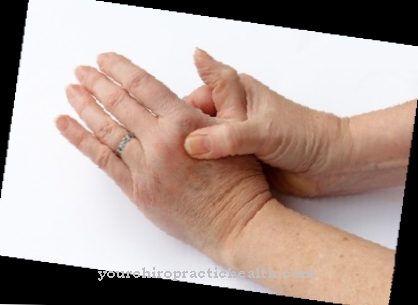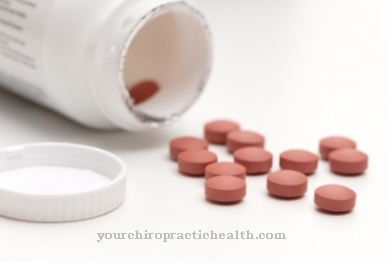At Guanethidine It is a drug that is used to treat hypertension (high blood pressure) and in local anesthesia to numb certain nerves. The main pharmaceutical producer of guanethidine is Alcon, which sells the active ingredient under the name Thilodigon®. Thus, guanethidine is both an antihypertensive and an antisympathotonic.
What is guanethidine?
Guanethidine is a drug that is used to treat high blood pressure. In addition, the medicinal agent guanethidine is able to block nerves so that it can be used for local anesthesia. In addition, guanethidine affects the sympathetic nervous system, which makes it suitable as an antisympathotonic.
The drug guanethidine belongs to the group of antihypertensive agents. Guanethidine is also among the synonymous terms Guanethidine monosulfate, Guanethidinum and Guanethidine sulfate known. However, drugs with guanethidine are currently no longer commercially available in numerous countries, for example Switzerland. Before that, doctors often prescribed the active ingredient guanethidine in the form of tablets with the trade name Ismelin®.
When used in medicines, guanethidine is used as guanethidine monosulfate. It is a crystalline powder with a white color. Guanethidine is relatively soluble in water and is one of the derivatives of guanidine. Guanethidine mainly affects the noradrenergic system. This inhibits the production of the neurological transmitter norepinephrine and reduces the storage capacity of certain neurons for the messenger substance.
Pharmacological effect on the body and organs
The effect of guanethidine is due to the fact that the substance reduces the production of norepinephrine. It is a neurological messenger substance that plays an important role in the transmission of stimuli. At the same time, taking guanethidine causes neurons to store less noradrenaline. Guanethidine thus shows similarities to the active ingredient reserpine.
In addition, the drug guanethidine stabilizes the membranes of the axon and reduces depolarizability. In this way, the active ingredient guanethidine is well suited for use in local anesthesia. Basically, guanethidine has a strong affinity for the systems and processes that transport the messenger substance noradrenaline in the nervous system. Doctors also refer to these processes in the jargon as noradrenaline pumps. The transport processes take place primarily in the membranes of the storage vesicles and axons. Thus, guanethidine reduces the clearance of extraneuronal catecholamines, so that adrenaline and noradrenaline act systemically longer. The drug guanethidine is therefore used in particular in people with high blood pressure, for whom other therapeutic measures show little or no success.
In principle, the ends of the nerve cells release less noradrenaline under the action of guanethidine, so that a smaller proportion of the messenger substance is present in the synaptic gap. At the beginning, the release of norepinephrine increases by taking guanethidine. However, under the influence of the drug, the responsible structures are unable to take up the norepinephrine produced again. Because the nervous system now stores the substance guanethidine.
In the context of local anesthesia, medical professionals use the fact that guanethidine reduces the sympathetic conduction of the nerves. However, guanethidine only blocks nerves in the limb area. The patients first receive a tourniquet, then the doctor injects the guanethidine into the vein. The drug lasts between one and three days. The fact that guanethidine does not work in the central nervous system is helpful here.
Medical application & use for treatment & prevention
The drug guanethidine is mainly used to treat high blood pressure. In addition, guanethidine is also suitable for local anesthesia, especially in the limb area. However, drugs containing guanethidine have since disappeared from the market in numerous countries.
Guanethidine is mainly available in the drug Ismelin®. The dosage of the tablets depends on the severity of the hypertension and the age of the patient. When using guanethidine in local anesthesia, doctors take into account the dose required in each individual case, which can be determined on the basis of the required intervention.
Risks & side effects
The use of guanethidine may cause some side effects, which should be considered by a doctor before prescribing. For example, the sensitivity to so-called catecholamines, which include the messenger substance adrenaline, increases. In stressful situations, patients sometimes suffer a blood pressure crisis.
Some male patients have difficulty ejaculating when taking guanethidine.Specifically, there is an aspermatism, whereby there is no ejaculation due to the lack of semen production. The active ingredient guanethidine affects the sex glands such as the prostate and thereby prevents the formation of secretions. Basically, however, it is a reversible side effect of the active ingredient guanethidine.
In addition to potential side effects, the interactions of guanethidine with other substances must also be considered. The active ingredient methylphenidate may reduce the hypotensive effect of the drug. In some cases, however, methylphenidate also increases the sympathomimetic mode of action of the drug guanethidine at the beginning of ingestion. For pregnant and breastfeeding women, special rules apply to the administration of guanethidine in order to avoid side effects for the child.



























